Andrew
Jackson Masonic Sculpture
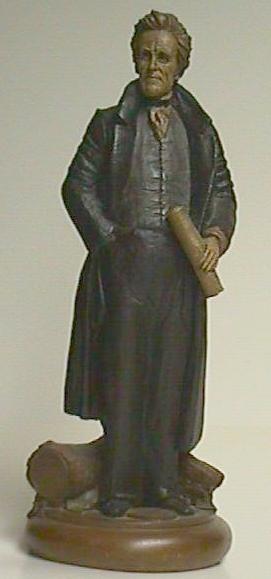
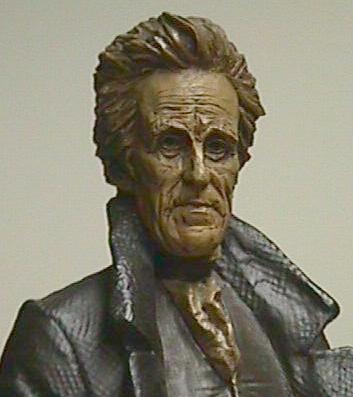
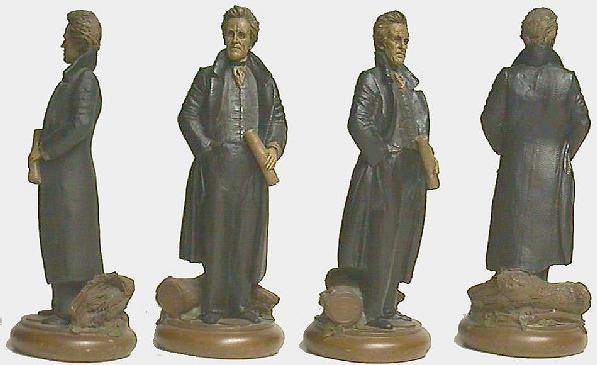
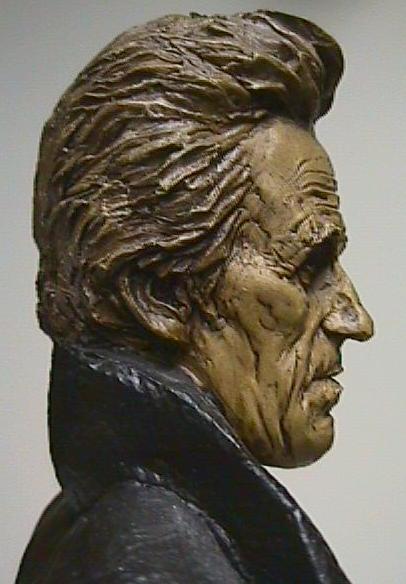
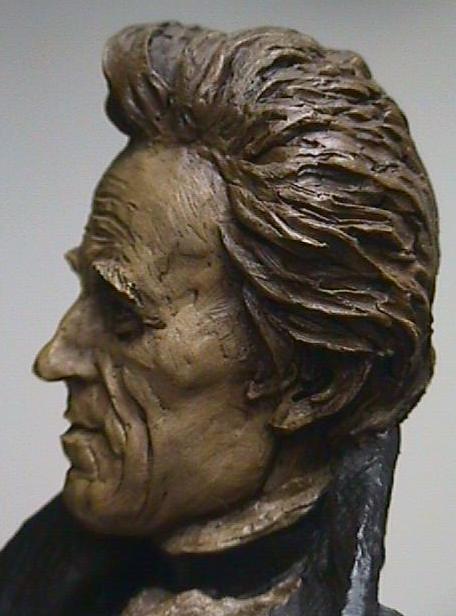

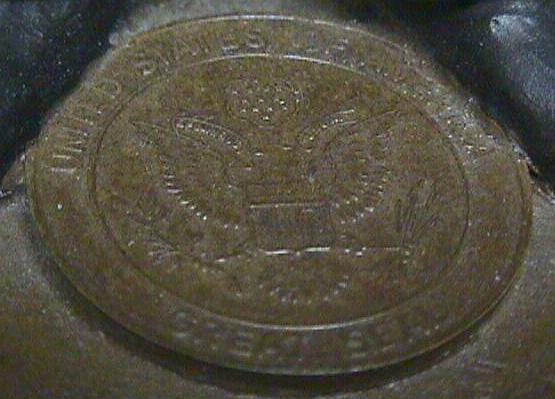

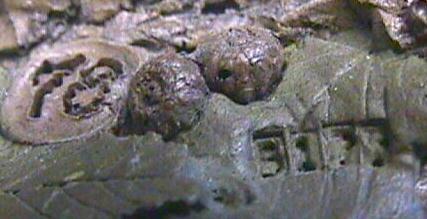
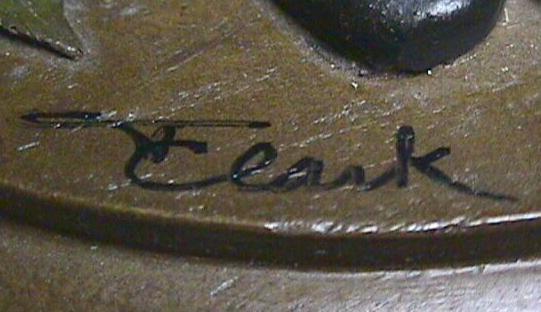
Brother Andrew
Jackson was the seventh president of the United States. In this signed
and numbered sculpture by T. Clark he is standing before an "Old Hickory"
branch which was a nickname bestowed upon him during the War of 1812 by
soldiers who declared him "tough as hickory." The coin on the
branch's cut edge is a mark, a token received by all York Rite Masons.
Jackson is claimed as a native son by both the North Carolina and Tennessee,
and it is still disputed if he was actually born in North or South
Carolina. I have visited his home, the Heritage, which stands near
Nashville, Tennessee and is now considered a national shrine. The sculpture is
reminiscent of Thomas Sully's portrait of Jackson, which was also the pose for
Jackson's portrait on the twenty-dollar bill. Brother Jackson is
depicted here during his presidential years (1829 - 1837) with the Great Seal
of the United States placed by his feet. Elected president at age 61, he
walked bareheaded to the Capitol for his inauguration, standing tall, lean and
ramrod straight. His formal dress may belie his reputation as the
president who was truly of and for the common man, and indeed, he was the
first president to be born in a log cabin. Known as a fighter both on
the battlefield and in the White House. Jackson's slogan was "Let
the people rule." This
sculpture weights in at 4.25 lbs. and stands 14 inches tall and is 5.5 inches
in diameter at its base. Each of the coins are affixed to the statue. The
Royal Arch Chapter Penney is 1 3/16 inches in diameter and The Great Seal coin
is 1.25 inches in diameter.

Masonic
History of Andrew Jackson
The
following is from the book "10,000 Famous Freemasons" By William R.
Denslow, Vol. II E - J, page 283.
Reprinted
from the Transactions of the Missouri Lodge of Research for the Educational
Bureau of the Royal Arch Mason Magazine.
This
book printed by the Macoy Publishing & Masonic Supply Co. Inc. Richmond,
Virginia. (4 book boxed set, Vol. I, II, III, IV.) Vol.
II, E - J, page 283.
Andrew Jackson
(1767-1845) Seventh
President of the United States. b. March 15, 1767 in Washaw settlement between
North and South Carolina. He was admitted to the bar in Salisbury, N.C.
in 1787, and, the following year, migrated westward to Nashville, Tenn.
Here he became a U.S. congressman (1796-97); U.S. senator (1797-98); judge of
the Tenn. Supreme Court (1798-1804); and major general of Tennessee militia
(1802). He defeated the Creek Indians at the Battle of Horseshoe Bend in
1814, and was made major general of U.S. Army and assigned to defend New
Orleans in the War of 1812. His defense of that city made him a national
hero. He added to his fame by operations against the Seminole Indians in
1818, and involved the federal government by pursuing Indians into Spanish
territory, and hanging two English troublemakers. He was governor of the
Florida Territory in 1821, and again U.S. senator in 1823-25. His first
presidential race in 1824 was unsuccessful, but he was elected in 1828, and
reelected in 1832. Under his administration the spoils system was
introduced, the national debt paid off, the United States Bank overthrown, and
the Peggy O'Neale scandal broke up his cabinet. There is doubt as to when and
where he received his degrees. An article in The Builder in 1925 states:
"The claim of Greeneville Lodge No. 3 of Tenn. (formerly No. 43 of N.C.)
seems to be the most weighty. An original transcript shows that he (Jackson)
was a member at that time." W. L. Boydon wrote in the New Age in
Aug. 1920: "The generally accepted belief is that he was made a
Mason in Philanthropic Lodge No. 12 at Clover Bottom, Davidson Co.,
Tenn." Bell, in his Famous Masons states: "Jackson was a
member of Harmony Lodge No. 1 (formerly St. Tammany Lodge No. 29 of N.C.)
Nashville, as early as 1800, but the date of receiving the degrees has not
been learned. He was present at the first meeting of Tennessee Lodge No. 2,
Knoxville, March 24, 1800. Charles Comstock, Past Grand Master of Tennessee and historian,
believes that he was a member of Harmony Lodge, and records a visit by him to
the initial meeting of Polk Lodge, U.D.1 Knoxville (dispensation granted Jan.
15, 1800) by "Andrew Jackson of Harmony Lodge of Nashville."
In 1808 Harmony Lodge No. 1 lost its charter, and here all record of Jackson's
Masonic affiliation ceases until 1822. He evidently kept in good
standing by paying his dues to the Grand Lodge, as was then permitted.
The proceedings of 1822 credit him with being a past master, but no record has
been found of his mastership. He was elected Grand Master of the
Grand Lodge of Tennessee, Oct. 7, 1822, and again in 1823, serving until Oct.
1824. He was elected an honorary member of Federal Lodge No. 1, Washington,
D.C., Jan. 4, 1830, and of Jackson Lodge No. 1, Tallahassee, Fla. as well as
the Grand Lodge of Florida (Jan. 15, 1833). He was a Royal Arch Mason, as he
served the Grand Chapter of Tennessee as Deputy Grand High Priest at its
institution, April 3, 1826, but no record exists of his affiliation with any
chapter. As was the custom at the time, the Royal Arch degree was
probably conferred by a blue lodge. He contributed $35.00 in 1818 to the
erection of a Masonic temple in Nashville; requested two Lodges to perform
funeral services; introduced Lafayette to the Grand Lodge of Tennessee in
1825; while president, assisted Washington's mother lodge to lay a cornerstone
of a monument to Washington's mother in Fredericksburg, Va. (May 6, 1833);
assisted in the Masonic laying of the cornerstone of Jackson City (across the
river from Washington, D.C.) on Jan. 11, 1836; attended the Grand Lodge of
Tennessee in 1839; and the same year visited Cumberland Chapter No. 1 of
Nashville to assist in the installation of officers. d. June 8,
1845.
A
special "Thanks" to Brother Jerry Stotler (jstot on eBay) for
submitting the pictures and description of this wonderful statue.

